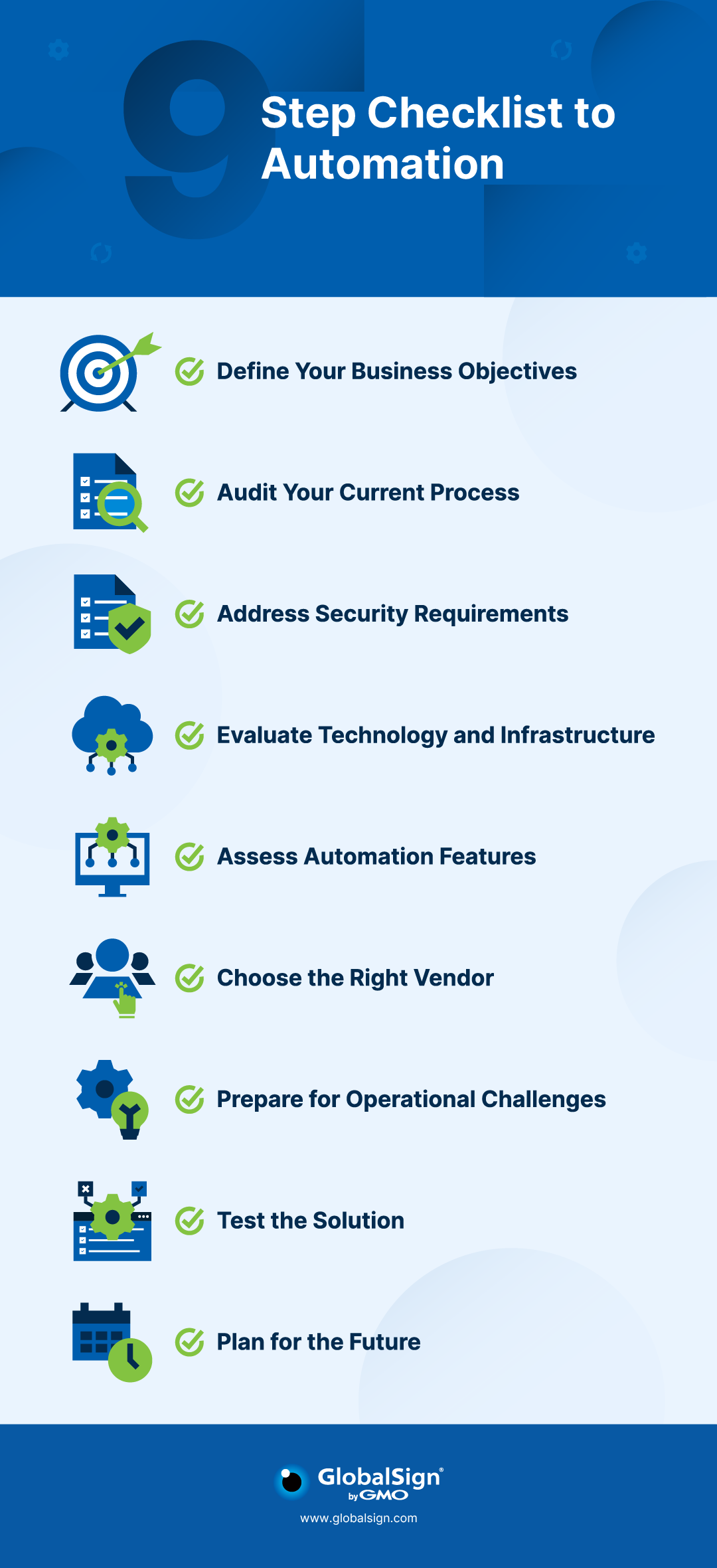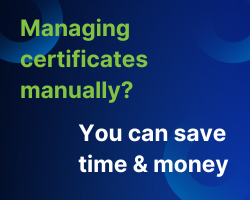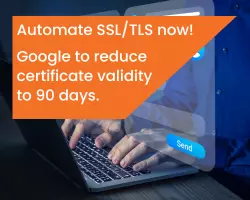With constantly evolving digital technology, businesses and organizations must continually re-evaluate and enhance critical processes to stay competitive. One key area to focus on is the management of digital certificates. Digital certificates are the backbone of secure online communications, but managing them manually has become increasingly challenging. With the growing complexity and volume of certificates, coupled with decreasing lifespans, it's clear that traditional methods are no longer sustainable or efficient.
Automating your certificate management can significantly reduce costs and improve efficiency. Embracing automation not only mitigates these risks but also offers numerous benefits: improved security and compliance, reduced human error, increased efficiency, and the ability to scale to meet growing demands. By automating your certificate management processes, you can ensure your organization is well-prepared to face the challenges of the future while achieving substantial cost savings.
The Problem with Manual Certificate Management
The first step to understanding why you should automate your certificate management at all; though the reasons are becoming increasingly apparent as managing digital certificates manually is becoming increasingly untenable for businesses. The sheer volume and complexity of certificates—ranging from SSL / TLS for websites to S/MIME for secure emails and Code Signing for software integrity—are growing rapidly. This expansion makes it increasingly difficult to keep track of all certificates, their expiration dates, and renewal processes.
- Human error is a significant concern with manual processes. Misconfigurations, missed renewal dates, and incorrect certificate installations can lead to serious security vulnerabilities. An expired certificate can cause service outages, disrupt business operations, and damage an organization's reputation. The administrative burden of manually managing certificates is also substantial. IT teams must dedicate considerable resources to monitor, renew, and replace certificates, diverting attention from more strategic initiatives and potentially leading to burnout among staff.
- Security risks are heightened with manual management. Expired or misconfigured certificates can create vulnerabilities that cybercriminals can exploit. Additionally, without automated key management, private keys may not be stored or rotated securely, further compromising security. This lack of robust key management practices can leave organizations exposed to significant threats.
- Compliance challenges add another layer of complexity. Many industries are subject to strict regulatory requirements regarding data security and privacy. Ensuring compliance with standards across industries, such as through the General Data Protection Regulation (GDPR), Health Insurance Portability and Accountability Act (HIPAA), and Payment Card Industry Data Security Standard (PCI-DSS) requires meticulous certificate management. Manual processes make it difficult to maintain the necessary level of oversight and documentation to meet these compliance standards.
- The decrease of certificate lifespans further adds to the challenge of manual management. Shorter lifecycles mean more frequent renewals, increasing the likelihood of errors and administrative overhead if managed manually. This constant cycle of renewals can overwhelm IT teams and lead to lapses in security.
Manual certificate management is fraught with risks and inefficiencies. The growing volume of certificates, coupled with the potential for human error and the administrative burden, make it clear that a more streamlined, automated approach is no longer a nice to have, it’s a necessity. By automating certificate management, organizations can mitigate these challenges, enhance security, and improve operational efficiency.

Automating Certificate Management: A Cost-Benefit Calculator
Automation is the cornerstone of online transformation in digital security. It enables you to quickly locate and securely manage all the certificates across your organization, reducing the risk of human error and freeing up valuable resources, leading to long-term cost-savings.
Discover the potential cost-benefits of automating your certificate management with our online calculator tool. By inputting your current number of certificates you manage, you can measure how much money you could be saving in relation to the potential decrease in certificate lifespans.
Calculate Your Cost-Benefits Here - US
Calculate Your Cost-Benefits Here - UK
Shifting to Automation: A 9 Step Checklist
As we transition to embracing automation, it's crucial to approach this shift methodically. One of the best ways to do this is by using a comprehensive checklist. By systematically addressing key areas it allows IT professionals to break down the automation process into manageable tasks, making it easier to implement and monitor progress. It helps ensure that no critical steps are overlooked and that your automation strategy is robust, secure, and tailored to your specific needs.

1. Define Your Business Objectives
Automation should align with your broader business goals. Try asking some key questions: What problems are you solving? Are you trying to reduce downtime caused by expired certificates, improve security, or scale to meet growing demands? Success will be different for each organization so defining what that means for your business and put metrics in place.
2. Audit Your Current Process
You can start by reviewing where you are now to measure your success against. Areas to consider include; the type of certificates you manage and their requirements, volume and frequency, issues, delays or errors.
3. Address Security Requirements
Digital certificates are all about trust and security, so automation must maintain or enhance your security posture. Consider; how will private keys be generated, stored, and rotated? Who has access to the automation tools? Are there regulations your organization needs to adhere to such as GDPR, HIPAA, or PCI-DSS?
4. Evaluate Technology and Infrastructure
Integrating with your existing tech stack must be seamless of automation to be feasible and effective. Ensure the system you choose provides support across operating systems, browsers, and device types; plus assess whether it has failover mechanisms to handle outages.
5. Assess Automation Features
You’ll know what features you do need from earlier steps, so look for a tool that has the capabilities that align with your specific needs. For example, if you only need to automate SSL/TLS certificates GlobalSign’s ACME service might be enough. However, if you manage various types of certificates and need features like automated issuance, renewal, revocation, expiration tracking, permissions, and complex reporting, you might require a more comprehensive solution like GlobalSign’s Certificate Automation Manager.
6. Choose the Right Vendor
Your automation platform is only as reliable as the vendor behind it. Trust is key. Key considerations usually include support, customer service, and price, but it would be worth evaluating the flexibility, chain of trust, longevity.
7. Prepare for Operational Challenges
Automation is not just a technological shift—it changes how your team operates. While automation saves time and money, you’ll still need to monitor and manage the system. A platform with robust dashboards and alerting capabilities will help you manage the change as well as minimize downtime.
8. Test the Solution
Start with a small-scale pilot to evaluate performance, compatibility and security vulnerabilities to validate the tool’s capabilities in your environment, before full deployment.
9. Plan for the Future
The digital landscape is constantly evolving, and your automation tools should keep up. You will want a tool that has the ability to react to your business needs; scaling up, down or changing direction all together. Any vendor you choose must be well versed in current regulations as well as prepared for developments like post-quantum cryptography .

Choosing the Right Automation Solution with GlobalSign
By utilizing GlobalSign’s automation solutions, you can ensure that your certificate management processes are not only efficient, but also secure and compliant. This proactive approach will help your organization navigate the evolving digital landscape with confidence, reducing the risk of outages and security breaches.
With GlobalSign’s automation solutions, you can:
- Find and Monitor Certificates: Easily locate and keep track of all internal and public-facing SSL/TLS certificates from a central location.
- Automate Certificate Provisioning: Provision all your certificates automatically based on preset policies, reducing IT workload and ensuring timely issuance.
- Ensure Compliance: Maintain adherence to baseline requirements and best practices, ensuring the integrity and security of your certificates.
- Manage Certificate Lifecycles: Keep track of issue dates and expiration dates to prevent unexpected outages and ensure continuous protection.
- Optimize IT Resources: Eliminate the need for manual monitoring and management, allowing your IT team to focus on more strategic tasks.
- Streamline Certificate Requests: Use an API or portal to request, view, and revoke certificates quickly and easily.
- Enhance Security: Ensure that the correct certificates are provisioned to endpoints, significantly reducing the risk of security breaches or loss of service.
- Support Multiple Protocols: Utilize SCEP, ACME, key archival, key roaming, and automated S/MIME configuration to meet diverse needs.
Start automating with a winning strategy in place that keeps your certificate inventory and management simple, straightforward, accurate, and automated.
Connect with our experts to discover which automation tools can work for you
Editor’s Note: This blog was originally published on February 27th, 2025 but has since been updated to reflect industry changes and new insights.








